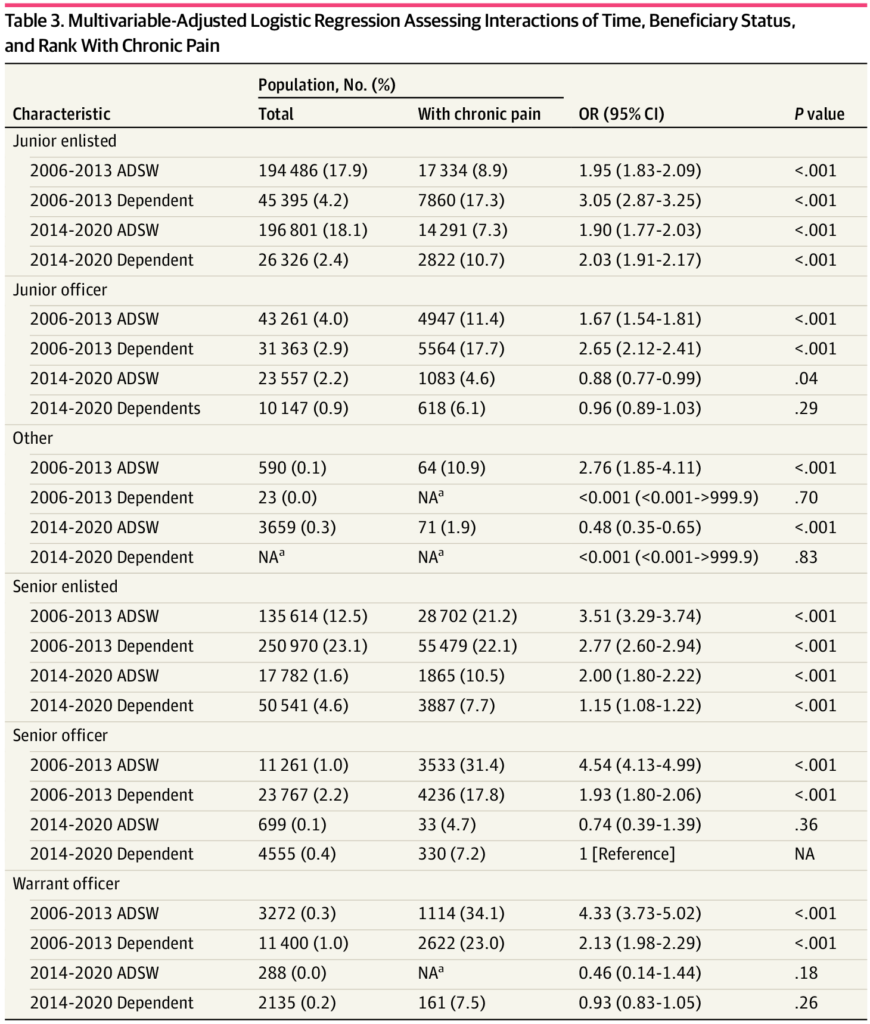Female Dependents Also Showed Adverse Effects

In 2021, a female U.S. Marine with the 24th Marine Expeditionary Unit (MEU) checked an Afghan woman as she went through the Evacuation Control Center (ECC) during an evacuation at Hamid Karzai International Airport in Kabul, Afghanistan. New research has suggested that deployment is linked to chronic pain in women servicemembers as well as female dependents waiting at home. U.S. Marine Corps photo by Staff Sgt. Victor Mancilla
BOSTON — The prevalence of chronic pain is documented to be several times higher in U.S. veterans than the general population. Efforts to deal with that unrelenting issue have led to myriad problems, including elevated rates of substance abuse.
The U.S. military recently completed its most prolonged period of combat exposure in its history (2001-2021), which raised the possibility that chronic pain would increase in new servicemembers, especially with changing demographics in the military.
Now, a new study published in JAMA Network Open has reported “strong and pervasive” signals for the association of combat exposure with the subsequent diagnosis of chronic pain in women serving in the military as well as female dependents waiting at home.1
“The incidence of chronic pain has been increasing over the last decades and may be associated with the stress of deployment in active-duty servicewomen (ADSW) as well as women civilian dependents whose spouse or partner served on active duty,” wrote researchers from Brigham and Women’s Hospital and Harvard Medicine School in Boston.
The Henry M. Jackson Foundation for the Advancement of Military Medicine and the Uniformed Services University of the Health Sciences, both in Bethesda, MD, also participated in the study.
The study team sought to determine if the incidence of chronic pain among active-duty servicewomen (ADSW) and women civilian dependents varied between 2006 and 2013, a period of heightened combat and deployment intensity, and 2014 to 2020, a period of reduced combat intensity.
To find out, the researchers conducted a cohort study including about 3.5 million ADSW and dependents, identifying significant differences in the diagnosis of chronic pain among ADSW and dependents in 2006 to 2013 compared with 2014 to 2020. Specifically, chronic pain was documented in 14.8% of ADSW in service during 2006 to 2013 and in 11.3% of dependents from this period, compared with 7.1% in ADSW and 3.7% of dependents from 2014 to 2020.

Click to Enlarge: Multivariable-Adjusted Logistic Regression Assessing Interactions of Time, Beneficiary Status, and Rank With Chronic PainAbbreviations: ADSW, active-duty servicewomen; NA not applicable or not available.
a. Data not available because cells with fewer than 10 individuals are censored. Source: JAMA Network Open
The authors pointed out, “The incidence of chronic pain has been increasing over the last decades and may be associated with the stress of deployment in active-duty servicewomen (ADSW) as well as women civilian dependents whose spouse or partner served on active duty.”
For the cohort study, the study team used claims data from the MHS data repository to identify ADSW and dependents who were diagnosed with chronic pain. The researchers compared the incidence of chronic pain among individuals associated with service from 2006 to 2013 to 2014 to 2020 incidence. Data were analyzed from September 2023 to April 2024.
A diagnosis of chronic pain was defined as the primary outcome in the study. Participants had a median age of 29, and 18.6% of them were ADSW.
Results indicated that, compared with ADSW in 2014 to 2020, ADSW in 2006 to 2013 had significantly increased odds of chronic pain (odds ratio [OR], 1.53; 95% CI, 1.48-1.58). The study found that the odds of chronic pain among dependents in 2006 to 2013 was also significantly higher compared with dependents from 2014 to 2020 (OR, 1.96; 95% CI, 1.93-1.99).
“The proxy for socioeconomic status was significantly associated with increased odds of chronic pain (2006-2013 junior enlisted ADSWs: OR, 1.95; 95% CI, 1.83-2.09; 2006-2013 junior enlisted dependents: OR, 3.05; 95% CI, 2.87-3.25),” the authors explained.
Disparate Support Structures
Noting that the cohort study found significant increases in the diagnosis of chronic pain among ADSW and civilian dependents affiliated with the military when deployment intensity was increased, the researchers pointed out, “The effects of disparate support structures, coping strategies, stress regulation, and exposure to military sexual trauma may apply to both women veterans and civilian dependents.”
Background information in the article advised that there are now more women combat veterans than at any other time in U.S. history. “The rigors of multiple deployments to combat zones have the potential to exert adverse effects on active-duty servicewomen (ADSW) as well as civilian women dependents whose spouse or partner served on active duty,” the researchers emphasized. “This includes not just the potential for actual combat injury but secondary effects from psychological stress, anxiety, and emotional trauma. The impact of these repeated aspects of combat deployments on the development of chronic pain in women servicemembers and dependents has not been adequately studied.”
They said that, to their knowledge, their cohort study is the first to longitudinally examine chronic pain development in a population of U.S. women, adding, “Our study cohort includes ADSW routinely exposed to combat environments and the rigors of war-related deployments, as well as the women civilian dependents of individuals on active duty. This effort is advantaged by the larger number of individuals considered, as well as the ability to longitudinally survey for the development of chronic pain irrespective of the time of onset, or the environment of care in which the diagnosis was made.”
The authors further noted that sociodemographic, educational and vocational diversity of the modern U.S. armed forces “allowed us to assess for intersectionality among socioeconomic status, proxies for combat exposure and the development of chronic pain in ways that smaller studies with more restricted populations are otherwise unable to achieve. Furthermore, these same characteristics of our cohort enable the translation of our findings to the working-age population of the U.S. as a whole, as previous work has found that the composition of individuals covered by the MHS are comparable with the US population aged 18 to 64 years.”
In the cohort studied, the overall incidence of chronic pain was 9.3%, which is comparable with prior estimates for chronic widespread pain among women as a whole, the researchers wrote.
“While the predilection for chronic pain disorders among U.S. veterans and others exposed to combat has been widely recognized in the literature, we believe that our investigation presents several novel paradigms,” they added. “First, our study suggests a greater adverse impact from heightened deployment schedules, given the statistical difference between the rates of chronic pain development between ADSW serving in 2006 to 2013 compared with ADSW in 2014 to 2020. That some of this difference is directly due to exposure to combat and related trauma is reinforced by the significant association between the polytrauma clinical triad and ADSW with chronic pain who were serving in 2006 to 2013.”
On the other hand, they pointed out, “However, the fact that the likelihood of chronic pain development was also significantly elevated among civilian dependent women from this same time period attests to the fact that the risk of chronic pain does not derive solely from combat exposure and the operational environment. The finding that civilian women dependents from 2006 to 2013 were at even higher odds of chronic pain than ADSW in this time frame was particularly surprising to us and indicates that the inimical effects of heightened deployment cycles extend well beyond the active-duty individual to include stressors, such as fear and worry about the safety of the deployed spouse or partner, assuming duties of a single parent, income alterations, and disruptions in social support.”
The potential for higher rates of chronic pain in women veterans appears to carry over to women dependents of combat veterans, according to the findings.
“At a minimum,” the authors pointed out, “our results hold immediate meaning for the MHS, Department of Veterans Affairs, and civilian health care systems that provide services for large numbers of civilian dependents of military servicemembers. The results regarding the associations of combat exposure and operational intensity with chronic pain development can be used by stakeholders in the future for resource allocation and deployment of support services that could mitigate risk.”
- Schoenfeld AJ, Cirillo MN, Gong J, et al. Development of Chronic Pain Conditions Among Women in the Military Health System. JAMA Netw Open. 2024;7(7):e2420393. doi:10.1001/jamanetworkopen.2024.20393

